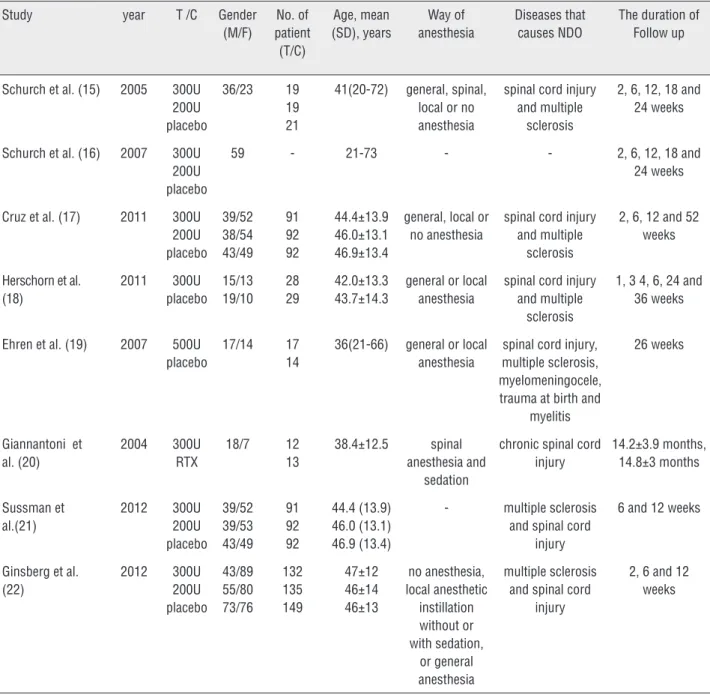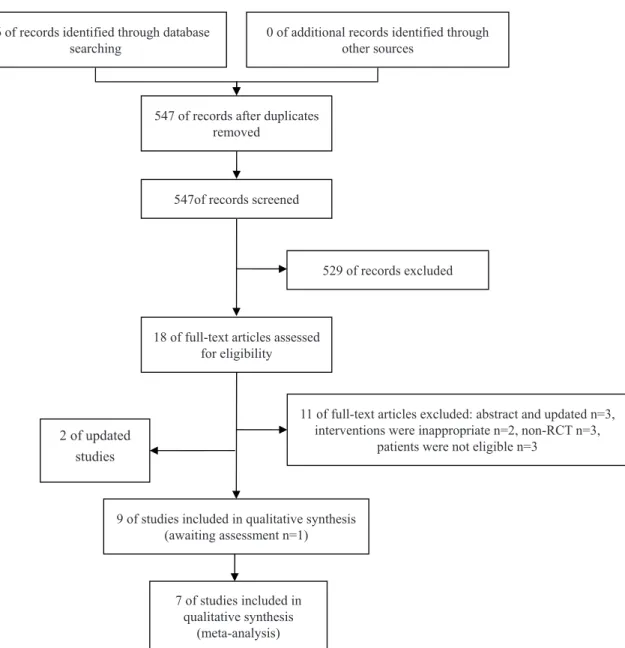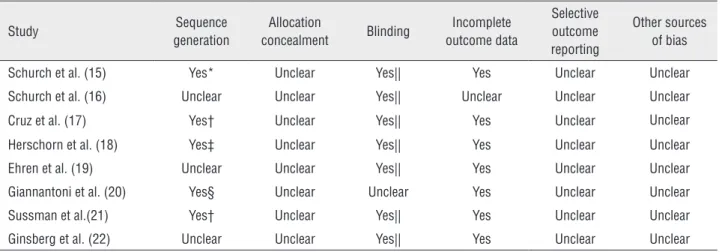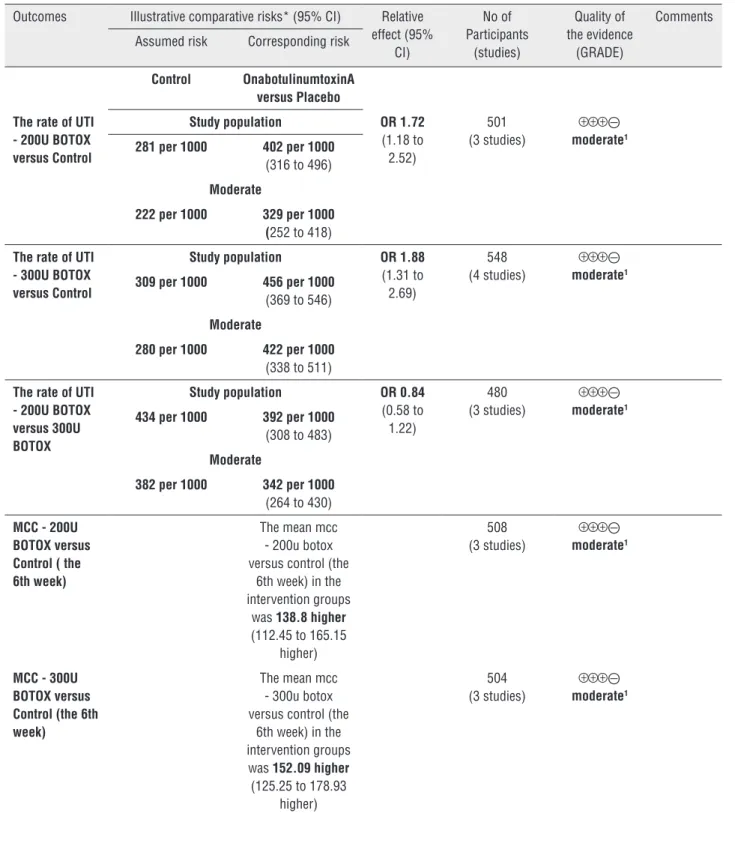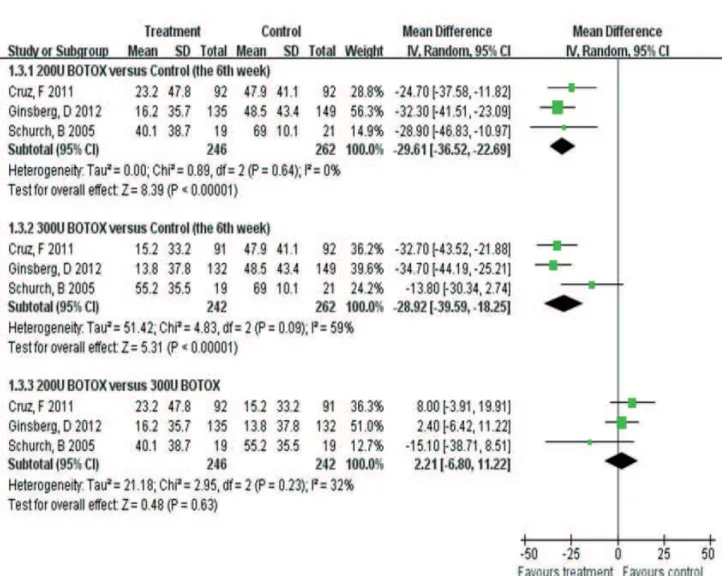OnabotulinumtoxinA for neurogenic detrusor overactivity
and dose differences: a systematic review
_______________________________________________
Rui Zhang
1,2, Yongteng Xu
1,3, Shengping Yang
4, Hui Liang
1,5, Yunxin Zhang
6, Yali Liu
1,7,81 The Evidence-Based Medicine Center, School of Basic Medical Sciences, Lanzhou University, Lanzhou,
China; 2 Liver Cancer Institute of Zhongshan Hospital, Fudan University, Shanghai, China; 3 Department of Neurology, Sun Yat-Sen Memorial Hospital, Sun Yat-sen University, Guangzhou, China; 4 Quanzhou Orthopedic-traumatologigal Hospital, Quanzhou 362000, China; 5 The First Clinical Medicine College of Lanzhou University, Lanzhou, China; 6 Department of Urology, Institute of Urology, The Second Hospital of Lanzhou University, Lanzhou, China; 7 Institute of Basic Research in Clinical Medicine, China Academy of Chinese Medical Sciences, Beijing, China; 8 Key Laboratory of Clinical Translational Research and Evidence-Based Medicine of Gansu Province, Lanzhou, China
ABSTRACT
ARTICLE
INFO
______________________________________________________________ ______________________
Purpose: To evaluate the efficacy and safety of onabotulinumtoxinA for patients with neurogenic detrusor overactivity (NDO).
Materials and Methods: We searched the Cochrane Library, PUBMED, EMBASE, Chi-nese Bio-medicine database, China Journal Full-text Database, VIP database, Wanfang database for randomized controlled trials (from inception to September 2012). Two authors independently selected studies, extracted data and assessed the methodological and evidence quality using the Cochrane Risk of Bias Table and GRADE (Grading of Re-commendations, Assessment, Development and Evaluation) respectively. Data analysis was performed by RevMan 5.1 and descriptive analysis was employed if necessary.
Results: Eight studies were selected (n=1879 participants). OnabotulinumtoxinA was more related to urinary tract infection (UTI) (200U: OR 1.72, CI: 1.18-2.52; 300U: OR 1.88, CI: 1.31-2.69) versus placebo. Also, OnabotulinumtoxinA was superior to placebo in improving maximum cystometric capacity (MCC) (200U: OR 138.80, CI: 112.45-165.15; 300U: OR 152.09, CI: 125.25-178.93) and decreasing maximum detrusor pres-sure (MDP) (200U: MD -29.61, CI: -36.52--22.69; 300U: MD-28.92, CI: -39.59--18.25). However, there were no statistical differences between 200U and 300U onabotulinu-mtoxinA in UTI (OR 0.84, CI: 0.58-1.22), MCC (OR-12.72, CI: -43.36-17.92) and MDP (MD 2.21, CI: -6.80-11.22).
Conclusions: OnabotulinumtoxinA may provide superior clinical and urodynamic be-nefit for populations with NDO. High-quality studies are required for evaluating the optimal dose, long-term application and when to perform repeated injections.
Key words: onabotulinumtoxinA [Supplementary Concept]; Randomized Controlled Trials as Topic; Meta-Analysis [Publication Type]; Review Literature as Topic
Int Braz J Urol. 2015; 41: 207-19
_____________________
Submitted for publication: March 19, 2014
_____________________
Accepted after revision: June 08, 2014
INTRODUCTION
Overactive bladder syndrome (OAB) is des-cribed as the urgency-frequency syndrome, with or without urgent urinary incontinence (1). One
have high transient bladder pressures. NDO nega-tively affects the quality of life (QoL) and causes complications within this population like depres-sion, poor sleep, urinary tract infections, skin in-fections and disturbances of sexual lives (3).
Current treatment options mainly consist of medications (antimuscarinic drugs), behavior adjust-ments (timing training, bladder retraining, pelvic floor training), surgeries and interventional thera-pies. Although symptoms can be improved, unsatis-factory effects still exist in many cases. For example, antimuscarinics, the first-line medication (4), can have troublesome side effects, such as dry mouth, constipation as well as blurred vision (5).
FDA approved onabotulinumtoxinA for the treatment of NDO in August 2011. Onabotu-linumtoxinA has exerted a positive impact on the urodynamic parameters, urinary continence and QoL (6, 7) by preventing the release of acetylcho-line at the neuromuscular junction in the afferent and efferent (8) pathways of the bladder wall, uro-thelium or lamina propria, to inhibit detrusor con-traction. Positioned between oral anticholinergic treatment that was ineffective or not tolerated and invasive surgery, this therapy is a minimally inva-sive treatment option (9). Economically, onabotu-linumtoxinA causes a significant reduction in the morbidity as well as in the costs associated with necessary medications (10).
Currently, to our knowledge, there is no consensus regarding the clinical effect of onabo-tulinumtoxinA on the NDO and different doses, though plenty of relevant articles have been pu-blished. Additionally, no articles have been sub-jected to grade the quality of the overall evidence. Systematic review is of great importance to sum-marize evidence accurately and reliably. We aim to provide more insight into these topics based on recent randomized controlled trials.
MATERIALS AND METHODS
Only randomized controlled trials were in-cluded.
Types of participants
Participants diagnosed with NDO that are defined by the International Continence Society
(ICS) (1) regardless of race, age, gender, course of disease and the origin of studies were included.
Types of interventions
OnabotulinumtoxinA was in the treat-ment group. The control group included any other interventions.
Types of outcome measures
Primary outcomes: Quality of life [scores of the QOL by means of the Incontinence QOL questionnaire, I-QOL (11); King’s Health Ques-tionnaire, KHQ (12)]. The most frequent adverse events: urinary tract infection (13).
Secondary outcomes: The frequency of urinary incontinence episodes; Two key uro-dynamic parameters: MCC (maximum cysto-metric capacity) and MDP (maximum detrusor pressure).
Search methods for identifiation of studies A comprehensive search was performed of the Cochrane Library (2012, 9 issue), PUBMED (1966 to September 2012), EMBASE (1974 to Sep-tember 2012), Chinese Bio-medicine database (1978 to September 2012), China Journal Full-text Database (1979 to September 2012), VIP database (1989 to September 2012), Wanfang database wi-thout language restrictions.
The main keywords were: urinary bladder diseases, bladder overactivity, detrusor overacti-vity, onabotulinumtoxina, clostridium botulinum toxins. Part of the databases applied subject hea-dings. Search strategies were adjusted adhering to characteristics of different databases. The search strategy for PUBMED is presented in supplemen-tary information.
DATA COLLECTION AND ANALYSIS
Selection of Studies
Assessment of risk of bias
The risks of bias of the included studies were independently assessed by two reviewers correlating with methods recommended by The Cochrane Colla-boration. It was judged by the following criteria: se-quence generation, allocation concealment, blinding, incomplete outcome data, selective outcome repor-ting and other sources of bias. These criteria were judged as: ‘Yes’ (low risk of bias), ‘No’ (high risk of bias), or ‘Unclear’ (unclear or unknown risk of bias).
QUALITY ASSESSMENT OF THE EVIDENCE
The overall quality of evidence was assessed for every outcome using GRADE (14) by one reviewer and was validated by a second person with the GRA-DE pro Version 3.6 software. Five study limitations (Limitations in study design or execution (risk of bias), inconsistency of results, indirectness of eviden-ce, imprecision and reporting bias) were assessed. The confidence of our estimated effect size was reflected through high, moderate, low or very low quality.
Statistical analysis
Statistical analysis was performed using the Review Manager software 5.1. Relative risk (RR) or odd ratio (OR), along with 95% confidence interval (CI) was calculated for dichotomous data. Mean diffe-rence (MD) with 95% confidence interval (CI) was cal-culated for continuous data. Heterogeneity between different studies was assessed by χ2test with p<0.10 used to indicate statistical significance and measu-re the quantity of heterogeneity, with I2>50% indi-cating significant heterogeneity. The meta-analysis was conducted using the fixed-effect model if there was no statistically significant heterogeneity (p≥0.10, I2≤50%). Otherwise, we initially analyzed the reasons of heterogeneity and pooled the data with random--effect models. Descriptive analysis was applied if the data could not be extracted for meta-analysis.
RESULTS
Description of studies
Our search included eight eligible studies (15-22) (Table-1). The flow of literature was sho-wn in the PRISMA flow chart (Figure-1).
Risk of bias in included studies and quality of evidence.
The methodology for the individual trial and summary of findings for the main compari-sons are delineated in Tables 2 and 3, respectively. We sent e-mails to the authors for unclear infor-mation, but no responses were received.
Effects of interventions scores for QoL
Four studies (16, 17, 21, 22) evaluated the impact of onabotulinumtoxinA 200U and 300U on QOL showing robust improvements in the mean change from baseline, which was significantly su-perior to the effect of placebo. Of these, one study (16) recorded I-QOL total scores (p<0.05) at week 2, 6, 12 and 24. The remaining three studies (17, 21, 22) recorded it at weeks 6 and 12 (p<0.001).
Two studies (18, 19) separately compared onabotulinumtoxinA 300U (18) and 500U (19) to placebo according to I-QOL total QOL scores (18) and the Qualiveen questionnaire (19), both sho-wing greater improvement from baseline.
The frequency of urinary incontinence episodes Compared to placebo, significant reduc-tion of the frequency of urinary incontinence epi-sodes in onabotulinumtoxinA group was seen in seven studies (15, 17-22).
Four studies (15, 17, 21, 22) compared ona-botulinumtoxinA 200U and 300U groups to place-bo. One study (15) revealed the decrease at weeks 12 and 18 in the 200 U onabotulinumtoxinA group. One study (21) reported the reduction at week 6 (-21.8 and-19.4 for the 200 and 300 U groups, res-pectively, vs.-13.2 for placebo; P<0.01). Cruz et al. (17) (200U: p<0.001, p<0.01, p<0.01; 300U: p<0.01, p<0.01, p<0.001) and Ginsberg et al. (22) (p≤0.008) showed the efficacy at weeks 2, 6, and 12. Fur-thermore, three studies (15, 17-22) found that there were no clinically relevant differences between the onabotulinumtoxinA dose groups.
Table 1 - Characteristics of included studies.
Study year T /C Gender
(M/F) No. of patient (T/C) Age, mean (SD), years Way of anesthesia Diseases that causes NDO
The duration of Follow up
Schurch et al. (15) 2005 300U 200U placebo
36/23 19 19 21
41(20-72) general, spinal, local or no anesthesia
spinal cord injury and multiple
sclerosis
2, 6, 12, 18 and 24 weeks
Schurch et al. (16) 2007 300U 200U placebo
59 - 21-73 - - 2, 6, 12, 18 and
24 weeks
Cruz et al. (17) 2011 300U 200U placebo 39/52 38/54 43/49 91 92 92 44.4±13.9 46.0±13.1 46.9±13.4
general, local or no anesthesia
spinal cord injury and multiple
sclerosis
2, 6, 12 and 52 weeks
Herschorn et al. (18) 2011 300U placebo 15/13 19/10 28 29 42.0±13.3 43.7±14.3
general or local anesthesia
spinal cord injury and multiple
sclerosis
1, 3 4, 6, 24 and 36 weeks
Ehren et al. (19) 2007 500U placebo
17/14 17 14
36(21-66) general or local anesthesia
spinal cord injury, multiple sclerosis, myelomeningocele, trauma at birth and
myelitis
26 weeks
Giannantoni et al. (20) 2004 300U RTX 18/7 12 13 38.4±12.5 spinal anesthesia and sedation
chronic spinal cord injury 14.2±3.9 months, 14.8±3 months Sussman et al.(21) 2012 300U 200U placebo 39/52 39/53 43/49 91 92 92 44.4 (13.9) 46.0 (13.1) 46.9 (13.4)
- multiple sclerosis and spinal cord
injury
6 and 12 weeks
Ginsberg et al. (22) 2012 300U 200U placebo 43/89 55/80 73/76 132 135 149 47±12 46±14 46±13 no anesthesia, local anesthetic instillation without or with sedation, or general anesthesia multiple sclerosis and spinal cord
injury
2, 6 and 12 weeks
T = The treatment group; C = The control group.
Adverse events
All studies reported adverse events. Of these, four studies (15, 17, 18, 22) reported the rate of UTI. There was no statistical heterogeneity between subgroup studies (200U: p=0.59, I2=0%; 300U: p=0.72, I2=0%; 200U versus 300U: p=0.35, I2=5%), and the pooled data showed that the rate in onabotulinumtoxinA 200U (OR 1.72, CI: 1. 18–
2.52) (15, 17, 22) and 300U(OR 1.88, CI: 1.31–2.69) (15, 17, 18, 22) (Figure-2) group was both signifi-cantly higher than that in placebo. Also, there was no statistical heterogeneity between the two treat-ment groups (OR 0.84, CI: 0.58–1.22) (15, 17, 22). MCC and MDP
po-Figure 1 - The flowchart of literature screening.
616 of records identified through database
searching 0 of additional records identified through other sources
547 of records after duplicates removed
547of records screened
529 of records excluded
18 of full-text articles assessed for eligibility
11 of full-text articles excluded: abstract and updated n=3, interventions were inappropriate n=2, non-RCT n=3,
patients were not eligible n=3
9 of studies included in qualitative synthesis (awaiting assessment n=1)
7 of studies included in qualitative synthesis
(meta-analysis)
2 of updated studies
oled the data of week 6 for MCC and MDP, and described the data for other weeks.
Week 6: For MCC, there was no statistical heterogeneity between subgroup studies (200U: p=0.81, I2=0%; 300U: p=0.95, I2=0%; 200U
ver-sus 300U: p=0.81, I2=0%). The result showed
that MCC in 200U (15, 17, 22) and 300U onabo-tulinumtoxinA (15, 17, 22) groups was both sig-nificantly bigger than that in placebo (200U: OR 138.80, CI: 112.45–165.15; 300U: OR 152.09,
CI: 125.25–178.93) (Figure-3). For MDP, there was statistically significant heterogeneity between trials (300U: p=0.09, I2=59%) (15, 17, 22).
Table 2 - Risk of bias in included studies.
Study Sequence
generation
Allocation
concealment Blinding
Incomplete outcome data
Selective outcome reporting
Other sources of bias
Schurch et al. (15) Yes* Unclear Yes|| Yes Unclear Unclear
Schurch et al. (16) Unclear Unclear Yes|| Unclear Unclear Unclear
Cruz et al. (17) Yes† Unclear Yes|| Yes Unclear Unclear
Herschorn et al. (18) Yes‡ Unclear Yes|| Yes Unclear Unclear
Ehren et al. (19) Unclear Unclear Yes|| Yes Unclear Unclear
Giannantoni et al. (20) Yes§ Unclear Unclear Yes Unclear Unclear
Sussman et al.(21) Yes† Unclear Yes|| Yes Unclear Unclear
Ginsberg et al. (22) Unclear Unclear Yes|| Yes Unclear Unclear
* = unique randomization number; † = an automated interactive voice or web response system; ‡ = sequential treatment assignment numbers; § = commercially available software; || = ‘double-blind’, but the objective of blinding wasn’t mentioned
300U: MD-28.92, CI: -39.59- -18.25) (Figure-4). Additionally, there were both no statistical di-fferences between 200U and 300U onabotulinu-mtoxinA in MCC (OR-12.72, CI: -43.36–17.92) (Figure-3) and MDP (MD 2.21, CI: -6.80–11.22) (Figure-4).
Other weeks: One study (15) revealed sig-nificant increases and decreases from baseline in MCC (p≤0.020) and MDP (p≤0.023) in each ona-botulinumtoxinA treatment group at all post--treatment time points. One study (18) described the outcome by the use of median showing im-provement in urodynamic parameters of ona-botulinumtoxinA group (MCC was improved at week 24(P=0.031); MDP was reduced at week 24 (P=0.0006), 36(P=0.0011). Similar findings existed in one study (19) (MCC was improved at 12 weeks (p=0.026); MDP was reduced (p<0.01) throughout the whole study period). One study (20) detected an improvement in MCC and MDP (p<0.01) in onabotulinumtoxinA group compared with RTX at 6, 12 and 18-month.
DISCUSSION
This research was designed in order to eva-luate onabotulinumtoxinA for patients with NDO. Five outcomes were monitored: quality of life, uri-nary incontinence episodes, adverse events, MCC
Table 3 - Summary of findings for the main comparisons
OnabotulinumtoxinA versus Placebo for NDO Patient or population: patients with NDO Settings:
Intervention: OnabotulinumtoxinA versus Placebo
Outcomes Illustrative comparative risks* (95% CI) Relative effect (95%
CI)
No of Participants
(studies)
Quality of the evidence
(GRADE)
Comments
Assumed risk Corresponding risk
Control OnabotulinumtoxinA versus Placebo
The rate of UTI - 200U BOTOX versus Control
Study population OR 1.72
(1.18 to 2.52)
501 (3 studies)
⊝
moderate1
281 per 1000 402 per 1000
(316 to 496)
Moderate
222 per 1000 329 per 1000 (252 to 418)
The rate of UTI - 300U BOTOX versus Control
Study population OR 1.88
(1.31 to 2.69)
548 (4 studies)
⊝
moderate1
309 per 1000 456 per 1000
(369 to 546)
Moderate
280 per 1000 422 per 1000
(338 to 511)
The rate of UTI - 200U BOTOX versus 300U BOTOX
Study population OR 0.84
(0.58 to 1.22)
480 (3 studies)
⊝
moderate1
434 per 1000 392 per 1000
(308 to 483)
Moderate
382 per 1000 342 per 1000
(264 to 430)
MCC - 200U BOTOX versus Control ( the 6th week)
The mean mcc - 200u botox versus control (the
6th week) in the intervention groups
was 138.8higher
(112.45 to 165.15 higher)
508 (3 studies)
⊝
moderate1
MCC - 300U BOTOX versus Control (the 6th week)
The mean mcc - 300u botox versus control (the
6th week) in the intervention groups was 152.09 higher
(125.25 to 178.93 higher)
504 (3 studies)
⊝
MCC - 200U BOTOX versus 300U BOTOX
The mean mcc - 200u botox versus
300u botox in the intervention groups
was 12.72 lower
(43.36 lower to 17.92 higher)
488 (3 studies) ⊝
moderate1
MDP - 200U BOTOX versus Control (the 6th week)
The mean mdp - 200u botox versus control (the
6th week) in the intervention groups
was 29.61 lower
(36.52 to 22.69 lower)
508 (3 studies) ⊝
moderate1
MDP - 300U BOTOX versus Control (the 6th week)
The mean mdp - 300u botox versus control (the
6th week) in the intervention groups
was 28.92 lower
(39.59 to 18.25 lower)
504 (3 studies) ⊝⊝
low1,2
MDP - 200U BOTOX versus 300U BOTOX
The mean mdp - 200u botox versus
300u botox in the intervention groups
was 2.21 higher
(6.8 lower to 11.22 higher)
488 (3 studies) ⊝
moderate1
*The basis for the assumed risk (e.g. the median control group risk across studies) is provided in footnotes. The corresponding risk (and its 95% confidence interval) is based on the assumed risk in the comparison group and the relative effect of the intervention (and its 95% CI). CI: Confidence interval; OR: Odds ratio.
GRADE Working Group grades of evidence
High quality = Further research is very unlikely to change our confidence in the estimate of effect.
Moderate quality = Further research is likely to have an important impact on our confidence in the estimate of effect and may change the estimate. Low quality = Further research is very likely to have an important impact on our confidence in the estimate of effect and is likely to change the estimate. Very low quality = We are very uncertain about the estimate.
1 From the result of risk of bias, sequence generation, allocation concealment and blinding of some studies were assessed as "unclear".
was a major bias on results, and was performed in seven studies (15, 17, 18-22). However, only three studies (18-20) revealed that patients treated with onabotulinumtoxinA could use a smaller amount of antimuscarinics; therefore, its potential impact on the efficacy of Botox cannot be definitely apprai-sed. Meanwhile, effective and well tolerated mono-therapy effect of BoNTA in patients with NDO has also been reported by Grise et al. (23).
There were clinical studies and systematic reviews (23, 24) concerning onabotulinumtoxinA for NDO. The Cochrane Review (24) was publi-shed on the same subject as our review but with some differences in design, such as types of
stu-dies and participants. Additionally, their conclu-sions have some other points that contrast with ours: 1. The Cochrane Review revealed that lower doses of botulinum toxin (100 to 150 U) appea-red to have beneficial effects, but larger doses (300 U) may have been more effective and longer lasting, but with more side effects. However, our review did not find clear dose differences (200 VS 300 U); 2. The Cochrane Review revealed that suburothelial injection had comparable efficacy to intradetrusor injection. However, our review did not compare different site injections because all included studies that applied intradetrusor in-jection. 3. The Cochrane Review indicated that the
effect of botulinum toxin may last for a number of months and is dependent upon dose and type of toxin used. However, our review was not designed specifically to assess duration of the clinical effect duo to inconsistent report of results. Moreover, our research was mainly about onabotulinumto-xinA for NDO due to the dearth of studies about onabotulinumtoxinB. Regrettably, in spite of some similar conclusions, long term outcomes, safety, and optimal dose of botulinum toxin for OAB all remain still unanswered. To our acknowledge, our systematic review is the first to highlight a dose difference in terms of clinical effect and grade the quality of evidence in accordance with GRADE to reflect the confidence of our estimated effect size.
However, it is still unknown whether higher or lower doses are more beneficial for patients due to the failure of finding clear difference between 200U and 300U. More studies should be initiated to determine the optimal dosage.
Methodological deficiency makes it difficult to reach more valid and reliable decisions. Six trials reported adequate randomization and one trial per-formed the exact allocation concealment. However, the remaining failed to mention the information above, which indicates the existence of selection bias. Seven trials performed blinding choice and most were double-blinded. Mostly, we considered objectives as patients and doctors. For subjective measurement, the score of QoL, was susceptible to
Figure 4 - Forest plot for the outcome of maximum detrusor pressure (MDP).
performance bias and detection bias. One trial failed to implement the blinding implying the possibility of performance bias.
During treatment, some failed to perform anesthesia before injection, while others required general, local and spinal anesthesia (Table-1). We should also pay close attention to those patients who have a failure or intolerance to onabotu-linumtoxinA to ensure its safety. The possible plausible explanation for this may be the emer-gence of an antibody or variation of axolemma receptor’s structures and tissues (25).
Some limitations for our systematic review should be acknowledged. First, published results were hindered by small sample size, and vague
limi-tations with the very large number of alternative approaches. For example, empirical evidence sup-porting the criteria is limited and attempts to show systematic difference between studies that meet or do not meet specific criteria shows inconsistent re-sults. Furthermore, the relative weight one should put on the criteria remains uncertain.
CONCLUSIONS
OnabotulinumtoxinA appears to be a cost--effective intervention for populations with NDO; however, the findings are not strongly definitive based on limited trials. In addition, we fail to find any dose differences.
Search Strategy for PUBMED
#1 Botulinum Toxin* OR botuli* OR Botulinu* to-xin* OR “Clostridium botulinum Toxins” OR “Clos-tridium botulinum” OR onobotulinumtoxin #2 “Botulinum Toxins”[Mesh]
#3 #1 OR #2
#4 “bladder overactivity” OR “detrusor overactivi-ty” OR “overactive urinary bladder” OR “overacti-ve bladder symptoms” OR “detrusor hyperreflexia” OR “urinary urgency” OR “urinary incontinence” OR “Urinary Bladder Diseases” OR “bladder dys-function”
#5 “Urinary Bladder Diseases” (Mesh) #6 #4 OR #5
#7 “Randomized Controlled Trial” (Publication Type)
#8 “Randomized Controlled Trials as Topic”(Mesh) #9 “Controlled Clinical Trial” (Publication Type) #10 “Controlled Clinical Trials as Topic”(Mesh) #11 randomized (Title/Abstract)
#12 placebo (Title/Abstract)
#13 drug therapy (MeSH Subheading) #14 randomly (Title/Abstract)
#15 trial (Title/Abstract) #16 groups (Title/Abstract)
#17 #7 OR #8 OR #9 OR #10 OR #11 OR #12 OR #13 OR #14 OR #15 OR #16
#18 “Animals” (Mesh) #19 “Humans” (Mesh)
#20 #18 NOT #19#21 #17 NOT #20 #22 #3 AND #6 AND #21
ACKNOWLEDGMENTS
The authors thank Tracy, Stacie, Bing Bai, Jinqiu Yuan and YuanjunTeng that provi-ded assistance with comments on revising the final manuscript. No financial or research fun-ding are disclosed.
CONFLICT OF INTEREST
None declared.
REFERENCES
1. Abrams P, Cardozo L, Fall M, Griffiths D, Rosier P, Ulmsten U, et al. Standardisation Sub-committee of the International Continence Society. The standardisation of terminology of lower urinary tract function: report from the Standardisation Sub-committee of the International Continence Society. Neurourol Urodyn. 2002;21:167-78.
2. Duthie J, Wilson DI, Herbison GP, Wilson D. Botulinum toxin injections for adults with overactive bladder syndrome. Cochrane Database Syst Rev. 2007;(3):CD005493. Update in: Cochrane Database Syst Rev.2011;(12):CD005493. 3. Giannantoni A, Mearini E, Del Zingaro M, Porena M. Six-year
follow-up of botulinum toxin A intradetrusorial injections in patients with refractory neurogenic detrusor overactivity: clinical and urodynamic results. Eur Urol. 2009;55:705-11. 4. Cameron AP. Pharmacologic therapy for the neurogenic
bladder. Urol Clin North Am. 2010;37:495-506.
5. Jundt K, Schreyer K, Friese K, Peschers U. Anticholinergic therapy: do the patients take the pills prescribed? Arch Gynecol Obstet. 2011;284:663-6.
6. Bagi P, Biering-Sørensen F. Botulinum toxin A for treatment of neurogenic detrusor overactivity and incontinence in patients with spinal cord lesions. Scand J Urol Nephrol. 2004;38:495-8.
7. Grosse J, Kramer G, Stöhrer M. Success of repeat detrusor injections of botulinum a toxin in patients with severe neurogenic detrusor overactivity and incontinence. Eur Urol. 2005;47:653-9.
8. Gomes CM, Castro Filho JE, Rejowski RF, Trigo-Rocha FE, Bruschini H, Barros Filho TE, et al. Experience with different botulinum toxins for the treatment of refractory neurogenic detrusor overactivity. Int Braz J Urol. 2010;36:66-74. 9. Schurch B, Stöhrer M, Kramer G, Schmid DM, Gaul G, Hauri D.
10. Wefer B, Ehlken B, Bremer J, Burgdörfer H, Domurath B, Hampel C, et al. Treatment outcomes and resource use of patients with neurogenic detrusor overactivity receiving botulinum toxin A (BOTOX) therapy in Germany. World J Urol. 2010;28:385-90.
11. Wagner TH, Patrick DL, Bavendam TG, Martin ML, Buesching DP. Quality of life of persons with urinary incontinence: development of a new measure. Urology. 1996;47:67-71; discussion 71-2.
12. Duckett JR, Hall S. A new questionnaire to assess the quality of life of urinary incontinent women. Br J Obstet Gynaecol. 1998;105:931.
13. Gamé X, Castel-Lacanal E, Bentaleb Y, Thiry-Escudié I, De Boissezon X, Malavaud B, et al. Botulinum toxin A detrusor injections in patients with neurogenic detrusor overactivity significantly decrease the incidence of symptomatic urinary tract infections. Eur Urol. 2008;53:613-8.
14. Balshem H, Helfand M, Schünemann HJ, Oxman AD, Kunz R, Brozek J, et al. GRADE guidelines: 3. Rating the quality of evidence. J Clin Epidemiol. 2011;64:401-6.
15. Schurch B, de Sèze M, Denys P, Chartier-Kastler E, Haab F, Everart K, et al. Botox Detrusor Hyperreflexia Study Team. Botulinum toxin type a is a safe and effective treatment for neurogenic urinary incontinence: results of a single treatment, randomized, placebo controlled 6-month study. J Urol. 2005;174:196-200.
16. Schurch B, Denys P, Kozma CM, Reese PR, Slaton T, Barron RL. Botulinum toxin A improves the quality of life of patients with neurogenic urinary incontinence. Eur Urol. 2007;52:850-8.
17. Cruz F, Herschorn S, Aliotta P, Brin M, Thompson C, Lam W, et al. Efficacy and safety of onabotulinumtoxinA in patients with urinary incontinence due to neurogenic detrusor overactivity: a randomised, double-blind, placebo-controlled trial. Eur Urol. 2011;60:742-50.
18. Herschorn S, Gajewski J, Ethans K, Corcos J, Carlson K, Bailly G, et al. Efficacy of botulinum toxin A injection for neurogenic detrusor overactivity and urinary incontinence: a randomized, double-blind trial. J Urol. 2011;185:2229-35. 19. Ehren I, Volz D, Farrelly E, Berglund L, Brundin L, Hultling
C, et al. Efficacy and impact of botulinum toxin A on quality of life in patients with neurogenic detrusor overactivity: a randomised, placebo-controlled, double-blind study. Scand J Urol Nephrol. 2007;41:335-40.
20. Giannantoni A, Di Stasi SM, Stephen RL, Bini V, Costantini E, Porena M. Intravesical resiniferatoxin versus botulinum-A toxin injections for neurogenic detrusor overactivity: a prospective randomized study. J Urol. 2004;172:240-3. 21. Sussman D, Patel V, Del Popolo G, Lam W, Globe D,
Pommerville P. Treatment satisfaction and improvement in health-related quality of life with onabotulinumtoxinA in patients with urinary incontinence due to neurogenic detrusor overactivity. Neurourol Urodyn. 2013;32:242-9. 22. Ginsberg D, Gousse A, Keppenne V, Sievert KD, Thompson
C, Lam W, et al. Phase 3 efficacy and tolerability study of onabotulinumtoxinA for urinary incontinence from neurogenic detrusor overactivity. J Urol. 2012;187:2131-9. 23. Grise P, Ruffion A, Denys P, Egon G, Chartier Kastler
E. Efficacy and tolerability of botulinum toxin type A in patients with neurogenic detrusor overactivity and without concomitant anticholinergic therapy: comparison of two doses. Eur Urol. 2010;58:759-66.
24. Duthie JB, Vincent M, Herbison GP, Wilson DI, Wilson D. Botulinum toxin injections for adults with overactive bladder syndrome. Cochrane Database Syst Rev. 2011;(12):CD005493.
25. Pellizzari R, Rossetto O, Schiavo G, Montecucco C. Tetanus and botulinum neurotoxins: mechanism of action and therapeutic uses. Philos Trans R Soc Lond B Biol Sci. 1999;354:259-68.
